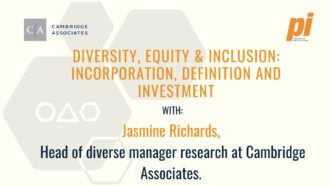It was not long ago that diversity was on the tongue of most chief executives in the financial services industry. Companies and investors, spurred on by political events, were united and vociferous in the call for greater diversity within their organisations.
Such talk has now gone somewhat quiet. And when it is spoken about, it is usually critical in nature. So has diversity fallen off the corporate and financial agenda?
Taking this position as a starting point: was all the talk about diversity nothing but noise? Could it be that financial organisations were never that committed to diversity, that they only went with the political tide when that tide was strong. Now that the politics of diversity has dissipated from the public discourse there is no need to pamper to it so much.
Although it could be that this premise is wrong. That although there is not as much noise surrounding diversity as there once was, it doesn’t mean there is nothing being done within financial institutions to address it.
On this, Annelise Sauter, ESG and equity diversity and inclusion manager at Better Society Capital, says the drive is still there. “While some organisations might be more politically tied, I believe financial services as a whole will continue to shift towards accepting and accelerating equity, diversity and inclusion.”
Going mainstream
It is a question Emma Douglas, senior stewardship analyst at Brightwell and co-chair of the Asset Owner Diversity Charter, addresses in more detail. “Has diversity fallen off the corporate agenda, or has it become more mainstream and more integrated into firms that there is not so much to shout about,” she says.
“It has certainly not fallen off asset owner agendas,” she adds. “We at the Asset Owner Diversity Charter continue to welcome more signatories, year-on-year.”
The charter does indeed have almost £2trn in assets under management signed up to the charter. “So I would say it’s not insignificant,” Douglas says.
A point shared by Sophia Singleton, president of the Society of Pension Professionals. “Media attention may have dwindled, but diversity and inclusion hasn’t fallen off the corporate agenda, and rightly so,” she says.
And Sauter adds: “Given that people are the lifeblood of the financial services industry, good equity, diversity and inclusion practices are just good governance, people management, investment and customer experience practices,” she says.
So on this evidence, asset owners may not be talking about diversity as much, but that is because they are getting on with it.
Another example that points in this direction is when the Asset Owner Diversity Charter held a conference on the issue around 100 people attended in person, with more online. “So diversity may have been quieter in the media, but people and organisations have been getting on with action to progress diversity, equity and inclusion (DEI) ambitions,” Douglas says.
New faces
Leaning into this interpretation of how things are progressing, Reboot, a working group of senior financial services professionals, revealed earlier this year that diversity is increasingly becoming an important part of UK fund managers winning business.
It is a trend Douglas and the Asset Owner Diversity Charter are seeing. “For an asset owner awarding a new mandate, DEI will usually be part of the manager selection process,” she says.
Although the evident problem here is that fund managers could take a tick-box approach to diversity, that is having enough diversity to win business, but ultimately nothing changes, except a few faces. “Doing diversity well leads to better idea generation, so it cannot be done tick boxy,” Douglas says.
Another point shared by Sophia Singleton. “Increasing DEI isn’t simply the right thing to do. Diversity, coupled with inclusive practices, broadens the skills base, increases innovation, reduces groupthink, can reduce staff turnover and helps better reflect the society we serve,” she says.
The less sexy stuff
Another reason to suggest that things haven’t gone quiet on the diversity front is that, as well as the Asset Owner Diversity Charter, there are initiatives within the pensions industry focusing on the diversity agenda to drive it forward as an important issue.
Last year The Pensions Regulator (TPR) published diversity, equity and inclusion guidance for pension schemes’ governing bodies and employers. And this year, TPR published its first trustee diversity and inclusion survey.
It revealed that 24% of trustees are female, compared to 52% of the general population, and 5% from an ethnic minority background, compared to 16% of the general population. “Improving the diversity of trustee boards and promoting inclusion should be a next step,” Singleton says.
The Diversity Project, a cross-company initiative championing a diverse UK investment and savings industry covering asset owners, investment managers, actuaries, trustees and wealth managers, has also taken off. The project has more than 100 members representing £13trn in assets under management.
But returning to the asset owner-asset manager dynamic, there is a big difference in terms on the importance of diversity and the size of asset manager. “It varies from manager to manager in how they deal with the issue,” Douglas says. “It can make a big difference, whether you are big global organisation or a small boutique. For the smaller managers it is even more important, because the culture generated within your firm is so fundamental to its success.”
Another indication towards the narrative of diversity being important is an increase in more managers completing the Asset Owner Diversity Charter questionnaire. “That, in part, is because of more signatories requesting it,” Douglas says. “So asset owner signatories to the charter and managers who are recipients of the questionnaire, means [asset managers] have to fill it out on an annual basis.”
This in turn creates a more holistic picture of what is happening on DEI within the investment industry.
And things have moved on within the debate, with organisations having to move with this, Douglas says. “At the outset, DEI was about the ambition. We had the leaders of all these organisations setting out their ambitions, which is what needed to happen.
“But the next thing is about policy and actual action,” Douglas adds. “How are you going to implement it – the less sexy stuff. What are organisations doing on a day-to-today basis to progress the diversity, equity and inclusion agenda.”
But how does that translate into reality and what does it mean for respective organisations? “The reality is if DEI is carried out properly, and in an effective manner, we, as asset owners, believe that, and research shows this, that you get better idea generation, better retention of staff and ultimately better business results,” Douglas says.
And this is, of course, the central tenet of why diversity is important in the first place.
Hiring and retaining
There are though other aspects to the diversity challenge. “The key aspect in all of this is the inclusion piece – it is super difficult,” Douglas says. That is to say, making companies truly inclusive. “Good companies are improving their recruitment process, and there has been significant progress in the early careers area – so more junior employees are from more diverse backgrounds,” Douglas adds.
This has proved harder, probably understandably, at the more senior level. “There has been slower action there,” Douglas says. “But it is also about the development and retention piece. That is where firms are starting to focus now,” she says.
The time taken to promotions for different groups is something the Asset Owner Diversity Charter is heavily focused on. “That is a company’s retention piece and bolsters the senior representation over a period of time,” Douglas says.
The charter also revealed many firms were offering mentoring programmes for diverse groups as part of improving this situation, but bizarrely none were tracking these programmes. “So they had no idea about take up rates or the success of those programmes. Yet it was a key part of the policy to develop and retain diverse talent,” Douglas says.
Don’t discriminate
But there can be said to be another drawback within the diversity debate and that comes from the advocates of diversity themselves who, sometimes, despite their best intentions, have been their worst enemy.
A case in point is the statement made by Amanda Blanc, Aviva’s experienced chief executive, who told a Treasury committee last year that there is no senior non-diverse, that is white male, hire made at Aviva without her personal approval. That looks, noted numerous critics, like discrimination, rather than a commitment to diversity.
It is here, where diversity could be seen as almost an obsession for its own sake. One where it begins to fall down as an effective tool to improve financial organisations. Diversity after all should exist as a basis for improving how a business or investment organisation is run, and that alone. Not as an ideology pursued for its own dogmatic purpose.
“We need to be mindful to take everyone along on the diversity journey,” Douglas says. “So do not alienate people, and certainly do not discriminate against anyone.”
Real benefits?
The other big question is whether focusing on diversity in a business context produces any real tangible benefits – despite all the talk that it inevitably does. Earlier this year, a report by the Inclusion at Work Panel, a group of private and public sector experts, found that many practices, including diversity training, had little to no tangible impact in increasing diversity or reducing prejudice.
Kemi Badenoch, the business secretary under the previous Conservative government, who commissioned the report, stated that many diversity and inclusion initiatives had been counter-productive despite millions of pounds having been dished out by companies on such plans.
Critics of Badenoch pointed out in turn that she was politicising the issue. But diversity, by its nature, is political. And it has become politicised to some small or large degree, on all sides.
There is a valid question to be asked about how some diversity training programmes benefit. For example, such initiatives on white privilege and gender identity, which are often offered as part of diversity programmes. How can these help investors make better investments and achieve a better return?
When it comes to the politics of DEI, Douglas has some practical advice. “Diversity is about firms getting things right, having that diversity of opinion, and should not just be about virtue signalling,” she says.
Diversity evolution
Another challenge is the simple fact that the diversity debate is continuously evolving. Douglas highlights the next point of concentration for diversity, as it has shifted from focusing on gender to ethnicity.
“Socio-economic background is the next big focus. We have adapted questions in the taskforce’s questionnaire this year following the [City of London Corporation’s] Socio-economic Diversity Taskforce recommendations,” she says. “The socio-economic side of things needs to be addressed.”
It could be said that this should have been the starting point in the diversity debate. As sticking to a focus on more women, or even greater ethnic diversity, you could achieve change, but in reality getting little difference on what existed before.
For example, you could replace a public-school Oxbridge educated white male CEO or CIO with a public-school Oxbridge educated white female, which would lean towards greater female diversity, but is hardly a great leap forward in diversity in any other measurement.
To highlight the socio-economic bias within British corporations, Douglas notes that when it comes to CEOs of UK organisations overall, 52% are from higher socio-economic backgrounds, but within finance, this figure increases to a whopping 89%. This will be a huge challenge to address.
From here diversity can still make a strong claim to be relevant to financial organisations and investors alike. And the sound of silence on the issue is not necessarily an indication of institutional investors pushing it out of sight.
But there is clearly, as the socio-economic argument highlights, much to be done. A point not lost on Sophia Singleton. “Much has been achieved, but much more change is required,” she says.





Comments